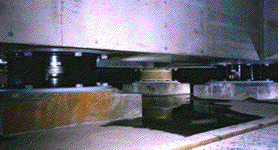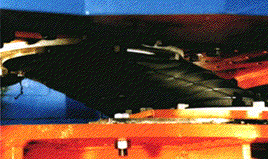 (Photo: Kajima Corp.)
(Photo: Kajima Corp.)SAFETY FIRST:
Buyers Opting for
Earthquake-Resistant Condominiums
APRIL 30, 1996
The experience of the Great Hanshin-Awaji Earthquake a year ago has led to a rush on the construction of condominiums boasting "earthquake resistance."
Features range from earthquake-resistant construction of the actual building to the provision of storage for emergency food supplies, wells, and emergency heliports. These dwellings are more expensive than ordinary apartments, but their popularity reflects a higher consciousness of safety.
 (Photo: Kajima Corp.)
(Photo: Kajima Corp.)
Reducing Sway
The adoption of such technology means that steel-reinforced concrete can be used rather than steel frames, so that beams and posts can be small, windows can be large, and more space is left available for storage, making for easier living.
One general contractor says that "earthquake-resistant" condominiums under construction in Saitama Prefecture, adjacent to Tokyo, have proved so popular that there were 18 prospective buyers for each available condominium. This has led to the hasty adoption of earthquake-resistant features not included in initial plans for a second group of buildings that is being built on the same site.
In line with the growing popularity of earthquake-resistant condos, an increasing number of companies in construction and real estate intend to build more such buildings in the future. An association established by the Ministry of Construction that inspects earthquake resistance technology, for instance, received requests for inspection of around 60 condominiums during January.
One type of "earthquake-resistant" condo winning popularity uses a construction method that dampens the shaking movement of an earthquake. This structure incorporates thin layers of rubber and steel plating that are sandwiched between the building and the ground, acting as a kind of a cushion.
 (Photo: Kajima Corp.)
(Photo: Kajima Corp.)
Food Storage and Heliports
There is an increasing number of privately-owned condominiums that have altered the designs of communal facilities and other features following last January's earthquake, such as by constructing emergency storage space for food and medical supplies and blankets and digging wells.
The number of condominiums put on the market during 1995 in the Tokyo metropolitan area was 85,000, of which 50,000 remain unsold. The battle to win over buyers is so fierce that consumers are being offered not just low prices but extras like sturdy construction methods and attractive facilities. And it appears that "earthquake-resistance" is becoming one of the most sought-after features.
Many condos are offering not only structural but also other disaster-prevention features. There is a a plan for an emergency heliport at a large-scale public housing complex being developed on four hectares (10 acres) of former factory grounds in Kawasaki City. Also planned at the complex are emergency warehouse facilities for food and other items and an area that can be used for disaster-prevention activities, making it a local gathering place in case of an emergency.
![]()